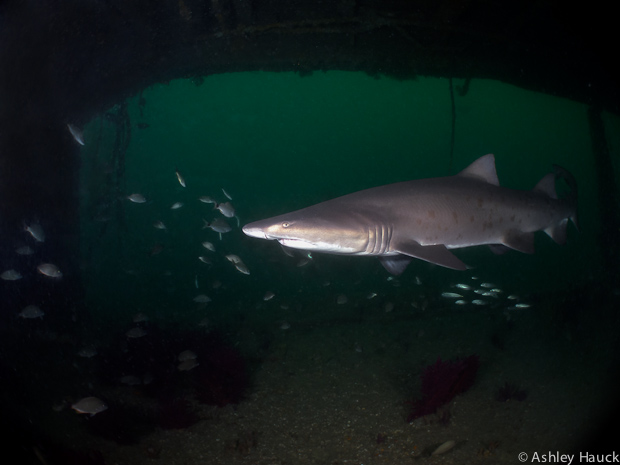After our ill-fated attempt to dive the caves of north Florida, we needed a Plan B if we were to salvage our trip. Armed with cell phones and hope, the three of us piled into our go-kart of a rental car and started the nine-hour drive north, making calls to dive shops and charter boats on the way.
It seemed like a tall order to find last-minute spots on a dive boat on Fourth of July weekend, but miraculously, all worked out. So Saturday morning we jumped on with Tortuga Charters and headed out to the wrecks.
North Carolina: Graveyard of the Atlantic
The waters off North Carolina’s Outer Banks entomb thousands of vessels and countless mariners who lost a desperate struggle against the forces of war, piracy and nature. The Graveyard of the Atlantic, with one of the highest densities of shipwrecks in the world, holds some of America’s most important maritime history […]
All along the Outer Banks lie shipwrecks associated with this rich heritage […]
–North Carolina Maritime Museums
Off the North Carolina coast, where the arctic Labrador current and the Gulf Stream meet, lies one of the premiere wreck diving destinations in the world. The treacherous waters have claimed ships since the 1500s (prompting the creation of lifesaving stations along the Outer Banks in the 1800s that would later incorporate into the United States Coast Guard). In addition to turbulent maritime conditions, piracy and warfare have laid down their fair share of vessels as well. Ships scuttled to create artificial reefs round out the fleet of diveable shipwrecks in the region.
During our weekend there, we only scratched the surface of the wreck diving North Carolina has to offer.
The Papoose
Saturday we dove the Papoose, a tanker torpedoed by the German submarine U-124 in 1942. The largely-intact 412-foot vessel rests upside-down in about 120 feet of water.
As it was my first dive in North Carolina, I had no idea what to expect. I was thrilled by the tropical blue Gulf Stream water and the masses of life.
The real thrill, though, came when we caught our first glimpses of the bigger residents of the wreck, the sand tiger sharks. So cool!
We also had a little run-in with a remora who was just a bit friendlier than usual… :)
U-352
Day two, our captain James Rosemond insisted that a dive trip to North Carolina wasn’t complete without visiting the German U-Boat U-352, one of the more famous tourist dives in the region. I wasn’t about to contest it as I’d wanted to dive a U-Boat since I started diving. The currents had shifted, bringing some of that mucky green water in from the north and making wide-angle photography more of a challenge. That said–it didn’t disappoint. It was so cool to be up close to a piece of war history, and definitely a different kind of boat than I’m accustomed to diving.
Aeolus
Our final dive in North Carolina was on the Aeolus, a 446-foot Navy cable layer sank in 1988 as an artificial reef. This wreck is big, dark, and absolutely riddled with sand tiger sharks. We dropped into the cable hold first thing and spent the better part of our dive just hanging out in there as the sand tigers circled us. Just amazing!















































